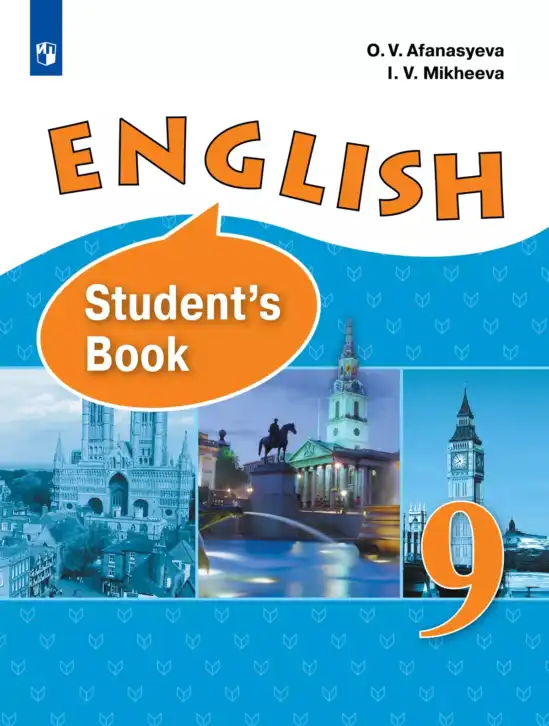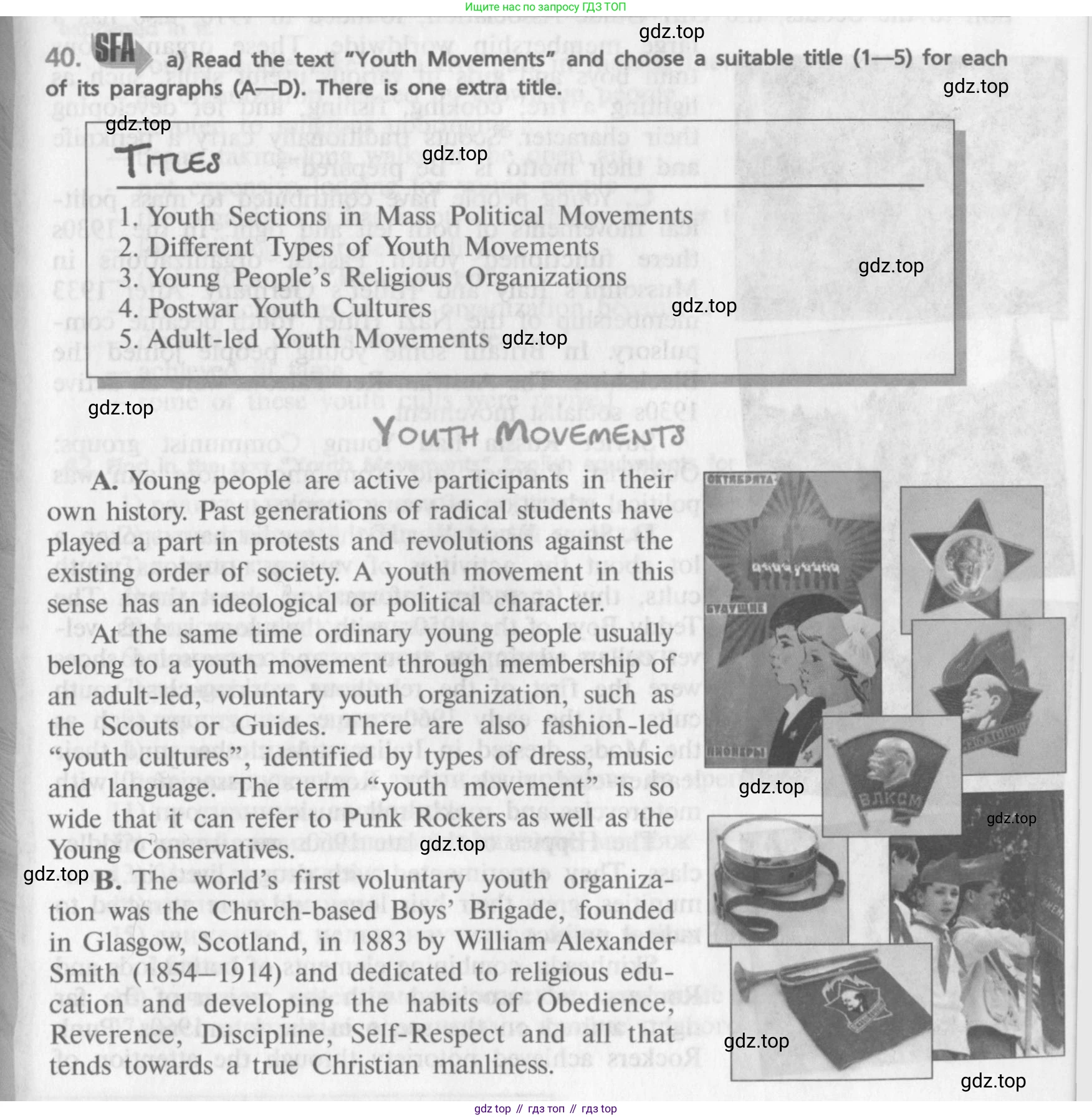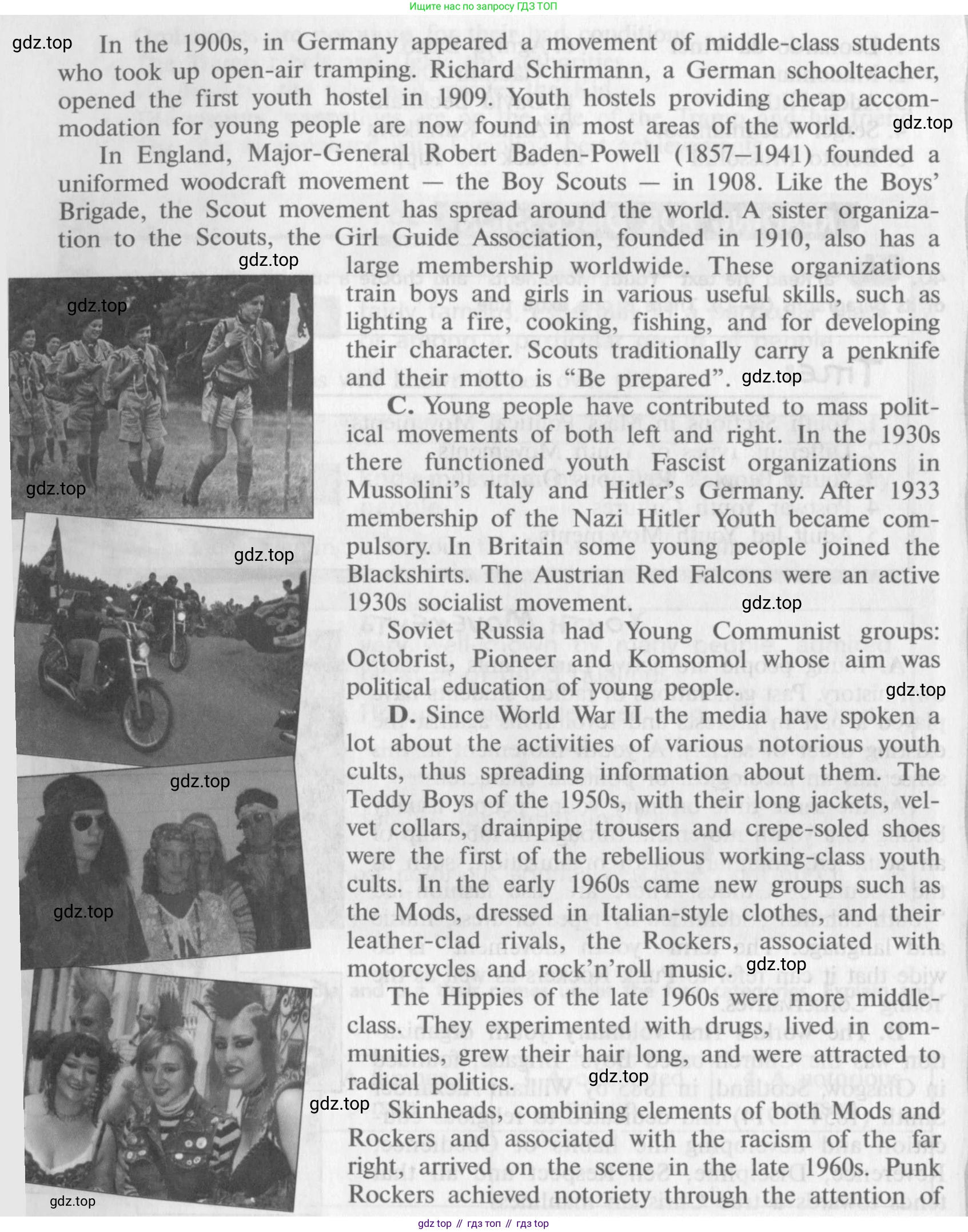Номер 40, страница 157 - гдз по английскому языку 9 класс учебник Афанасьева, Михеева

Авторы: Афанасьева О. В., Михеева И. В.
Тип: Student's book (Учебник)
Издательство: Просвещение
Год издания: 2014 - 2025
Уровень обучения: углублённый
Цвет обложки: голубой, белый
ISBN: 978-5-09-034231-5
Рекомендовано Министерством образования и науки Российской Федерации
Популярные ГДЗ в 9 классе
Unit 3. You are only a teenager once. Reading for discussion - номер 40, страница 157.
№40 (с. 157)
Условие. №40 (с. 157)
скриншот условия



40. SFA
a) Read the text "Youth Movements" and choose a suitable title (1–5) for each of its paragraphs (A–D). There is one extra title.
TITLES
1. Youth Sections in Mass Political Movements
2. Different Types of Youth Movements
3. Young People's Religious Organizations
4. Postwar Youth Cultures
5. Adult-led Youth Movements
YOUTH MOVEMENTS
A. Young people are active participants in their own history. Past generations of radical students have played a part in protests and revolutions against the existing order of society. A youth movement in this sense has an ideological or political character. At the same time ordinary young people usually belong to a youth movement through membership of an adult-led, voluntary youth organization, such as the Scouts or Guides. There are also fashion-led "youth cultures", identified by types of dress, music and language. The term "youth movement" is so wide that it can refer to Punk Rockers as well as the Young Conservatives.
B. The world's first voluntary youth organization was the Church-based Boys’ Brigade, founded in Glasgow, Scotland, in 1883 by William Alexander Smith (1854–1914) and dedicated to religious education and developing the habits of Obedience, Reverence, Discipline, Self-Respect and all that tends towards a true Christian manliness.
In the 1900s, in Germany appeared a movement of middle-class students who took up open-air tramping. Richard Schirrmann, a German schoolteacher, opened the first youth hostel in 1909. Youth hostels providing cheap accommodation for young people are now found in most areas of the world.
In England, Major-General Robert Baden-Powell (1857–1941) founded a uniformed woodcraft movement – the Boy Scouts – in 1908. Like the Boys’ Brigade, the Scout movement has spread around the world. A sister organization to the Scouts, the Girl Guide Association, founded in 1910, also has a large membership worldwide. These organizations train boys and girls in various useful skills, such as lighting a fire, cooking, fishing, and for developing their character. Scouts traditionally carry a penknife and their motto is "Be prepared".
C. Young people have contributed to mass political movements of both left and right. In the 1930s there functioned youth Fascist organizations in Mussolini's Italy and Hitler's Germany. After 1933 membership of the Nazi Hitler Youth became compulsory. In Britain some young people joined the Blackshirts. The Austrian Red Falcons were an active 1930s socialist movement. Soviet Russia had Young Communist groups: Octobrist, Pioneer and Komsomol whose aim was political education of young people.
D. Since World War II the media have spoken a lot about the activities of various notorious youth cults, thus spreading information about them. The Teddy Boys of the 1950s, with their long jackets, velvet collars, drainpipe trousers and crepe-soled shoes were the first of the rebellious working-class youth cults. In the early 1960s came new groups such as the Mods, dressed in Italian-style clothes, and their leather-clad rivals, the Rockers, associated with motorcycles and rock'n'roll music. The Hippies of the late 1960s were more middle-class. They experimented with drugs, lived in communities, grew their hair long, and were attracted to radical politics. Skinheads, combining elements of both Mods and Rockers and associated with the racism of the far right, arrived on the scene in the late 1960s. Punk Rockers achieved notoriety through the attention of the media in the late 1970s, with their unique "Mohican" hairstyles, vivid make-up, cast-off clothes and aggressive music. Several of these youth cultures were recycled in the 1980s.
b) Listen to the text (14) and prepare an artistic reading following the pattern given in the recording.
Решение. №40 (с. 157)


Решение 2. №40 (с. 157)
40. a) Прочитайте текст 'Молодежные движения' и выберите подходящий заголовок (1-5) для каждого из его абзацев (A-D). Один заголовок лишний. b) Прослушайте текст (аудио 14) и подготовьте выразительное чтение по образцу, данному в записи.
Ответ:
a)
A - 2. Different Types of Youth Movements (Различные типы молодежных движений)
B - 5. Adult-led Youth Movements (Молодежные движения под руководством взрослых)
C - 1. Youth Sections in Mass Political Movements (Молодежные секции в массовых политических движениях)
D - 4. Postwar Youth Cultures (Послевоенные молодежные культуры)
Другие задания:
Помогло решение? Оставьте отзыв в комментариях ниже.
Присоединяйтесь к Телеграм-группе @top_gdz
ПрисоединитьсяМы подготовили для вас ответ c подробным объяснением домашего задания по английскому языку за 9 класс, для упражнения номер 40 расположенного на странице 157 к Учебник (Student's book) 2014 года издания для учащихся школ и гимназий.
Теперь на нашем сайте ГДЗ.ТОП вы всегда легко и бесплатно найдёте условие с правильным ответом на вопрос «Как решить ДЗ» и «Как сделать» задание по английскому языку к упражнению №40 (с. 157), авторов: Афанасьева (Ольга Васильевна), Михеева (Ирина Владимировна), ФГОС (старый) углублённый уровень обучения учебного пособия издательства Просвещение.















